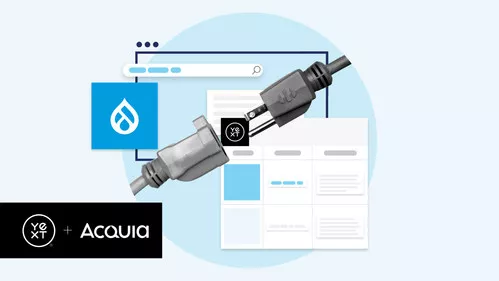Why a knowledge graph is essential for natural language search
- 7 minute read
-
This is the second blog post in a series of blogs from Yext, highlighting how adding natural language powered AI search to your website can help you provide a best-in-class web experience. If you missed the first blog, check it out here!
Knowledge Graph: The Foundation of Your Natural Language Search Experience
Yext helps you to create an optimized search experience, like Google, on your Acquia site. The foundation of that experience is a Knowledge Graph.
What is a Knowledge Graph
Whether they realize it or not, users have been retrained to search in question form using natural language, entering queries like “Which convenience store is open until 9 PM and closest to me?” As a direct result, they’re becoming accustomed to getting the right answers to their increasingly complex questions at the tip of their fingers. While Drupal is extremely powerful, it doesn’t have natural language processing built in to store this type of information. In order for a brand to deliver those right answers, they need to store all of their information in one place, which is built to structure data for AI Search. *Enter: the Yext Knowledge Graph*
So what is a knowledge graph? A knowledge graph is a brain-like database that is structured with entities such as people, places, help articles, and events and their relationships. This structures your data in a way that lends itself to natural language understanding, which is likely a main reason why search experts around the world like Google and Amazon use them.
With your own knowledge graph, you’ll have:
- A structured data backend needed to power your natural language experiences
- The ability to power site search that delivers direct answers
- The foundation for a seamless customer journey so customers can engage, interact and, ultimately convert
It’s important to note that clearly defining your goals and how you want to position your brand to make the biggest impact online is critical. Once you’ve landed on your entities and their relationships, you can start to build a knowledge graph that will help you to accomplish your business goals.
Building a Yext Knowledge Graph
Once you’ve identified your organization’s various entities, it’s time to unlock the full power of the knowledge graph with relationships that link those entities. Because of its semantic structure, the Yext Knowledge Graph enables search experiences to understand your customers’ intent — what they are actually looking for in the real world — and can get them exactly what they need. Store any type of data, whether it's structured, semi-structured, or unstructured. Yext gives you the flexibility to get set up quickly using built-in entity and field types or create your own.
The connections between data complete the picture and allow you to build AI search experiences that make sense and deliver value. Connect your entities via a one way, two way, or undirected relationships. For example, you can create a relationship between your products and locations, so customers can always know which locations carry your various products.

Let’s say you’re a restaurant owner and are running a hamburger special. Since your knowledge graph already has the menu and location information and understands the relationships between these entities, any customer that searches for “Are you selling the hamburger special at the 5th Street location?” will receive a direct answer.

Getting your data into the Knowledge Graph
The most powerful knowledge graphs are robust with data that reflect your entire business, but it can be challenging to unify that data into a single source. Yext’s Data Connectors give you the flexibility to create and manage integrations with one user-friendly tool, making it even easier and faster to build your knowledge graph.
Your data likely lives across a number of different environments, so we matched your workflow and made it as easy as possible to get your data into the knowledge graph. Yext has built a variety of integrations to connect data to the knowledge graph, including file uploads, APIs, the Web Crawler, Apps, and pre-built applications with technology partners such as Drupal! The way the knowledge graph works is a natural extension of Drupal’s core entity model, since Drupal stores structured data in the form of “entities” that can have multiple relationships to other entities in the CSM.
With the Drupal Data Connectors, you can easily pull in built in content types based on the Acquia CMS content model. Our five new out of the box connectors allow you to pull in Articles, People, Pages, Places, and Events data with a few clicks. If you are already using a Yext solution, you can instantly access these in your account by clicking on the Apps tab and then the Directory tab.
Once you have your Drupal data in your knowledge graph, you can easily add it to the search experience on your Drupal site. Check out this guide for more information on how to use the connectors and add your Drupal data to your Answers Search Experience.
Knowledge Graph powers your AI Search on Your Drupal Site
Giving your users an intuitive and powerful search experience is vital for numerous reasons such as increased customer satisfaction and time spent on site, but it requires the right strategy. Yext provides the fastest, easiest, and most powerful approach to AI search available today, and it gives you an immediate advantage over everyone else. With the turn key integration available in Drupal, you can get started immediately and focus on delivering the best experience possible with the best tools available.

Learn more about how Yext and Acquia can help you boost on-site conversion, reduce bounce rates, and gain new customer intelligence.
Check out Yext’s Documentation or Hitchhikers guide for how to integrate Answers with Drupal. You can also learn more about Yext's Drupal integrations in this on-demand webinar.






